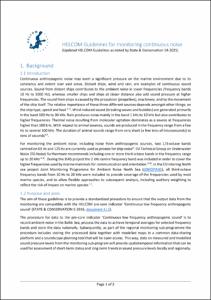HELCOM Guidelines for monitoring continuous noise.

View/
Average rating
votes
Date
2018Corporate Author
HELCOM
Status
PublishedPages
10pp.
Metadata
Show full item recordAbstract
Continuous anthropogenic noise may exert a significant pressure on the marine environment due to its constancy and extent over vast areas. Distant ships, wind and rain, are examples of continuous sound sources. Sound from distant ships contributes to the ambient noise in lower frequencies (frequency bands 10 Hz to 1000 Hz), whereas smaller ships and ships at closer distance also add sound pressure at higher frequencies. The sound from ships is caused by the propulsion (propellers), machinery, and by the movement of the ship itself. The relative importance of these three different sources depends amongst other things; on the ship type, speed and load 1–3. Wind-induced sound (breaking waves and bubbles) are generated primarily in the band 100 Hz to 30 kHz. Rain produces noise mainly in the band 1 kHz to 10 kHz but also contributes to higher frequencies. Thermal noise resulting from molecular agitation dominates as a source at frequencies higher than 100 kHz. With respect to animal source.....
Publisher
HELCOMHelsinki, Finland
Document Language
enSustainable Development Goals (SDG)
14.1Essential Ocean Variables (EOV)
Ocean soundMaturity Level
MatureSpatial Coverage
Baltic SeaCitation
HELCOM (2018) HELCOM Guidelines for monitoring continuous noise. Helsinki, Finland, HELCOM, 10pp. DOI: http://dx.doi.org/10.25607/OBP-1800Collections
- CAPARDUS Practices [244]
- HELCOM Manuals and Guidelines [49]
 Repository of community practices in Ocean Research, Applications and Data/Information Management
Repository of community practices in Ocean Research, Applications and Data/Information Management